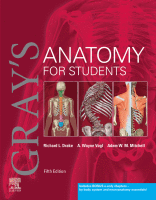Physical Address
304 North Cardinal St.
Dorchester Center, MA 02124

General organization The nervous system allows us both to detect and respond to our external environment and to monitor and control our viscera. The brain and spinal cord are central in position and are wired to the rest of the…

General organization The lymphatic system is a network of thin-walled vessels throughout the body that collect fluid lost from the capillary beds during nutrient exchange and return it to large veins in the root of the neck. This fluid also…

General organization Parts of the urinary and reproductive (genital) systems are closely related developmentally, so the two systems are often discussed together. The urinary system consists of the kidneys, ureters, bladder, and urethra. In women, major parts of the reproductive…

General organization The gastrointestinal system can be separated into the upper gastrointestinal tract, consisting of the oral cavity (mouth), pharynx, and esophagus, and the lower gastrointestinal tract, consisting of the abdominal organs. Oral cavity The oral cavity is inferior to…

General organization The respiratory system can be divided into the upper airway (consisting of the nose and nasal cavity), pharynx, and lower airway (consisting of the larynx, trachea, and lungs). Nose and nasal cavity The two nasal cavities are the…

General organization The cardiovascular system consists of the heart, which pumps blood throughout the body, and the blood vessels, which are a closed network of tubes that transport the blood. There are three types of blood vessels: ▪ Arteries—which transport…

Part I: Nervous system overview The nervous system is structurally divided into the central nervous system (CNS) and peripheral nervous system (PNS) ( eFig. 9.1 ). Components of the CNS are the brain and spinal cord, which are enclosed by…

ADDITIONAL LEARNING RESOURCES for Chapter 8, Head and Neck, can be Found on the Accompanying Ebook: Conceptual overview General Description The head and neck are anatomically complex areas of the body. Head Major compartments The head is composed of a…

ADDITIONAL LEARNING RESOURCES for Chapter 7, Upper Limb, CAN BE FOUND ON THE ACCOMPANYING EBOOK: Conceptual overview General Description The upper limb is associated with the lateral aspect of the lower portion of the neck and with the thoracic wall.…

ADDITIONAL LEARNING RESOURCES for Chapter 6, Lower Limb, can be Found on the Accompanying Ebook Conceptual overview General Description The lower limb is directly anchored to the axial skeleton by a sacroiliac joint and by strong ligaments, which link the…